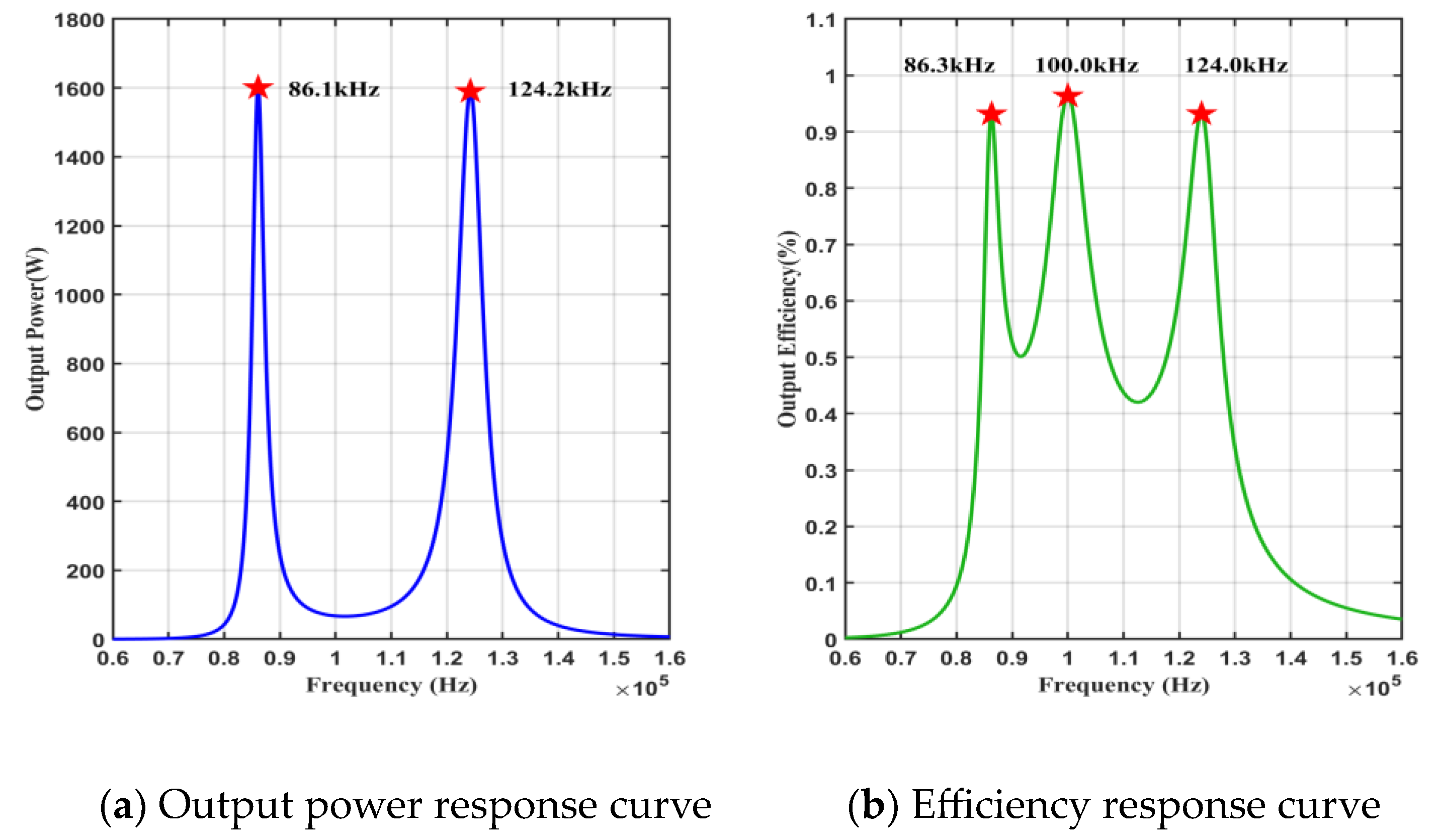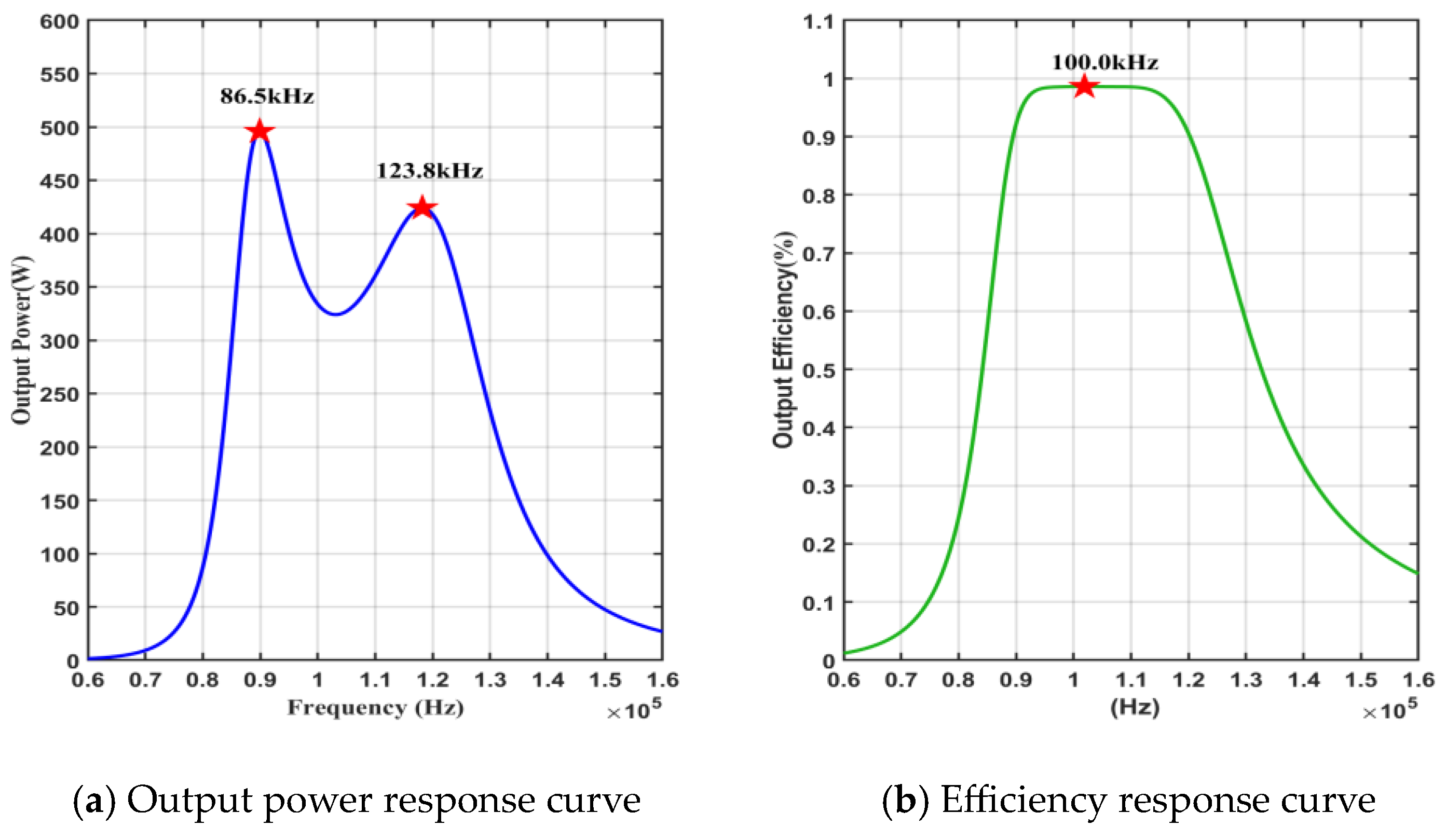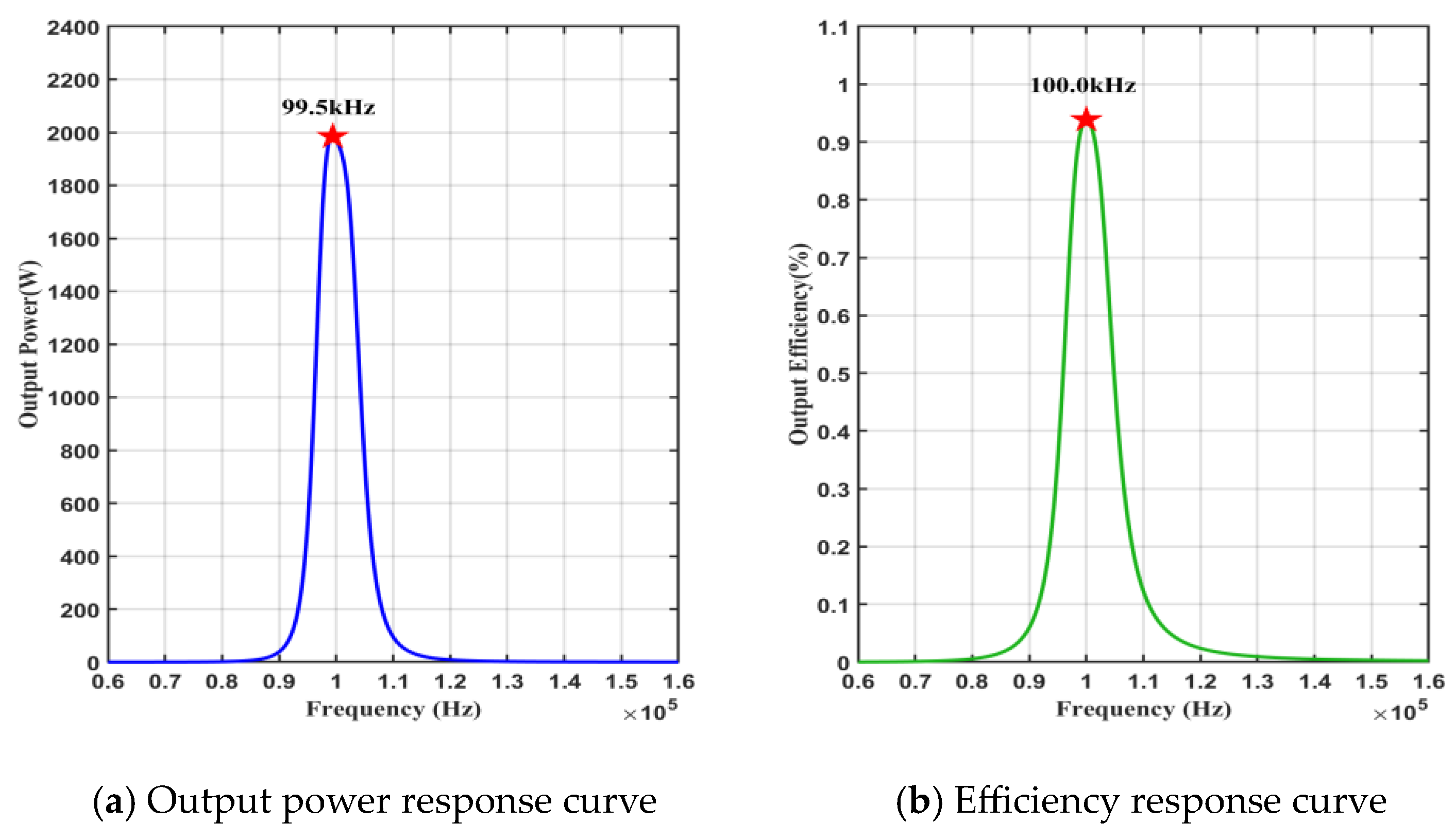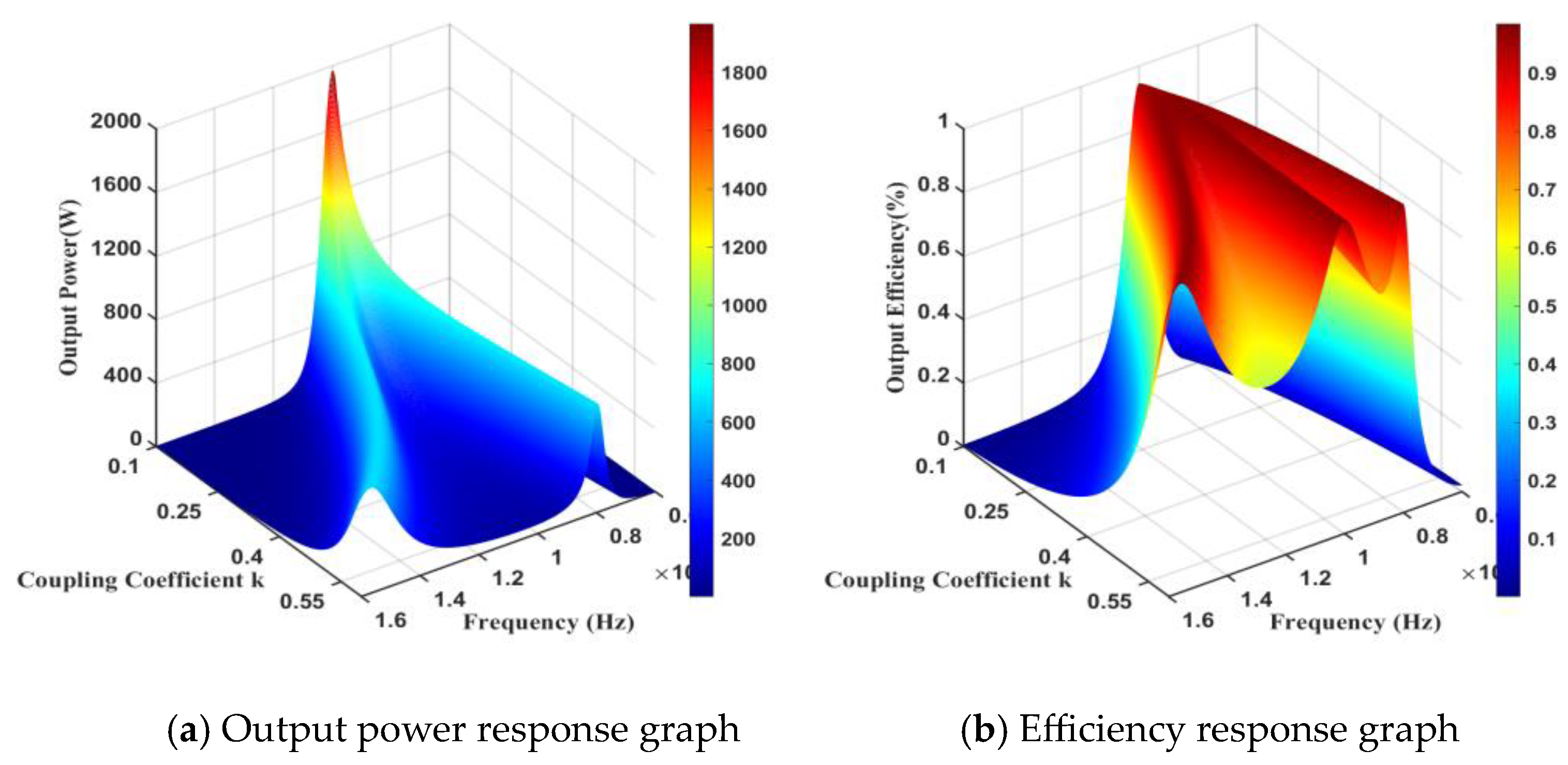Research on Wireless Power Transfer Method for Intelligent Sensing Device of Non-Directly Buried Distribution Cables
Abstract
1. Introduction
2. Principle of WPT Technology
3. Power and Efficiency Characterizations
3.1. Power-Frequency Splitting Characteristics
3.2. Efficiency-Frequency Splitting Characteristics
3.3. Synchronous Power-Efficiency Characteristics
4. Parameter Analysis and Calculation of WPT Systems
4.1. Modeling and Simulation of WPT Systems
4.2. Effect of Equivalent Loads
4.2.1. Simulation Results for Variable Equivalent Loads
4.2.2. Analysis of Simulation Results
4.3. Effect of Coupling Coefficients
4.3.1. Simulation Results for Variable Coupling Coefficients
4.3.2. Analysis of Simulation Results
4.4. Validation of the Efficacy Property Equation
4.4.1. Computer Calculation Verification
4.4.2. Three-Dimensional Image Verification
5. Conclusions
Author Contributions
Funding
Data Availability Statement
Conflicts of Interest
References
- Barman, S.D.; Reza, A.W.; Kumar, N.; Karim, M.E.; Munir, A.B. Wireless powering by magnetic resonant coupling: Recent trends in wireless power transfer system and its applications. Renew. Sustain. Energy Rev. 2015, 51, 1525–1552. [Google Scholar] [CrossRef]
- Eteng, A.A.; Rahim, S.K.A.; Leow, C.Y.; Chew, B.W.; Vandenbosch, G.A.E. Two-Stage Design Method for Enhanced Inductive Energy Transmission with Q-Constrained Planar Square Loops. PLoS ONE 2016, 11, e0148808. [Google Scholar] [CrossRef] [PubMed][Green Version]
- Kim, T.-H.; Yun, G.-H.; Lee, W.Y. Asymmetric Coil Structures for Highly Efficient Wireless Power Transfer Systems. IEEE Trans. Microw. Theory Tech. 2018, 66, 3443–3451. [Google Scholar] [CrossRef]
- Choroszucho, A.; Pieńkowski, C.; Jordan, A. Electromagnetic wave propagation into building constructions. Przegląd Elektrotechniczny 2008, 84, 44–49. [Google Scholar]
- Sun, L.; Ma, D.; Tang, H. A review of recent trends in wireless power transfer technology and its applications in electric vehicle wireless charging. Renew. Sustain. Energy Rev. 2018, 91, 490–503. [Google Scholar] [CrossRef]
- Luo, Z.; Wei, X. Analysis of Square and Circular Planar Spiral Coils in Wireless Power Transfer System for Electric Vehicles. IEEE Trans. Ind. Electron. 2018, 65, 331–341. [Google Scholar] [CrossRef]
- Inoue, K.; Kusaka, K.; Itoh, J.I. Reduction in radiation noise level for inductive power transfer systems using spread spectrum techniques. IEEE Trans. Power Electron. 2018, 33, 3076–3085. [Google Scholar] [CrossRef]
- Tang, S.C.; Lun, T.L.T.; Guo, Z.; Kwok, K.W.; McDannold, N.J. Intermediate range wireless power transfer with segmented coil transmitters for implantable heart pumps. IEEE Trans. Power Electron. 2017, 32, 3844–3857. [Google Scholar] [CrossRef]
- Kan, T.; Mai, R.; Mercier, P.P.; Mi, C.C. Design and analysis of a three-phase wireless charging system for lightweight autonomous underwater vehicles. IEEE Trans. Power Electron. 2017, 33, 6622–6632. [Google Scholar] [CrossRef]
- Moiduddin, K.; Mian, S.H.; Ameen, W.; Alkindi, M.; Ramalingam, S.; Alghamdi, O. Patient-Specific Surgical Implant Using Cavity-Filled Approach for Precise and Functional Mandible Reconstruction. Appl. Sci. 2020, 10, 6030. [Google Scholar] [CrossRef]
- Li, X.; Zhang, H.; Peng, F.; Li, Y.; Yang, T.; Wang, B.; Fang, D. A wireless magnetic resonance energy transfer system for micro implantable medical sensors. Sensors 2012, 12, 10292–10308. [Google Scholar] [CrossRef] [PubMed]
- Fitzpatrick, D.C. Implantable Electronic Medical Devices; Academic Press: San Diego, CA, USA, 2014; pp. 7–35. [Google Scholar]
- Bukhari, M.U.; Khan, A.; Maqbool, K.Q.; Arshad, A.; Riaz, K.; Bermak, A. Waste to energy: Facile, low-cost and environment-friendly triboelectric nanogenerators using recycled plastic and electronic wastes for self-powered portable electronics. Energy Rep. 2022, 8, 1687–1695. [Google Scholar] [CrossRef]
- Van Toan, N.; Thi Kim Tuoi, T.; Van Hieu, N.; Ono, T. Thermoelectric generator with a high integration density for portable and wearable self-powered electronic devices. Energy Convers. Manag. 2021, 245, 114571. [Google Scholar] [CrossRef]
- Latest 97 Mobile Phone List with Qi Certification by WPC Wireless Charging Alliance–Chongdiantou. Available online: https://www.chongdiantou.com/archives/26813.html (accessed on 8 May 2023).
- Hammi, B.; Zeadally, S.; Khatoun, R.; Nebhen, J. Survey on smart homes: Vulnerabilities, risks, and countermeasures. Comput. Secur. 2022, 117, 102677. [Google Scholar] [CrossRef]
- Maharjan, P.; Salauddin, M.; Cho, H.; Park, J.Y. An indoor power line based magnetic field energy harvester for self-powered wireless sensors in smart home applications. Appl. Energy 2018, 232, 398–408. [Google Scholar] [CrossRef]
- Sun, Q.; Han, J.; Li, H.; Liu, S.; Shen, S.; Zhang, Y.; Sheng, J. A Miniature Robotic Turtle With Target Tracking and Wireless Charging Systems Based on IPMCs. IEEE Access 2020, 8, 187156–187164. [Google Scholar] [CrossRef]
- Lü, X.; Deng, R.; Chen, C.; Wu, Y.; Meng, R.; Long, L. Performance optimization of fuel cell hybrid power robot based on power demand prediction and model evaluation. Appl. Energy 2022, 316, 119087. [Google Scholar] [CrossRef]
- Tan, Z.; Liu, F.; Chan, H.K.; Gao, H.O. Transportation systems management considering dynamic wireless charging electric vehicles: Review and prospects. Transp. Res. Part E Logist. Transp. Rev. 2022, 163, 102761. [Google Scholar] [CrossRef]
- Jin, Y.; Xu, J.; Wu, S.; Xu, L.; Yang, D. Enabling the Wireless Charging via Bus Network: Route Scheduling for Electric Vehicles. IEEE Trans. Intell. Transp. Syst. 2021, 22, 1827–1839. [Google Scholar] [CrossRef]
- Allamehzadeh, H. Wireless Power Transfer (WPT) Fundamentals with Resonant Frequency-Dependent Parameters, Energy Transfer Efficiency, and Green Technology Applications. In Proceedings of the 2021 IEEE 48th Photovoltaic Specialists Conference (PVSC), Fort Lauderdale, FL, USA, 20–25 June 2021. [Google Scholar]
- Fang, Y.; Qu, J.; Pong, B.M.H.; Lee, C.K.; Hui, R.S.Y. Quasi-Static Modeling and Optimization of Two-Layer PCB Resonators in Wireless Power Transfer Systems for 110-kV Power Grid Online Monitoring Equipment. IEEE Trans. Ind. Electron. 2022, 69, 1400–1410. [Google Scholar] [CrossRef]
- Baby, T.; Madhu, G.; Renjith, V.R. Occupational electrical accidents: Assessing the role of personal and safety climate factors. Saf. Sci. 2021, 139, 105229. [Google Scholar] [CrossRef]
- Goh, H.H.; Huang, Y.; Lim, C.S.; Zhang, D.; Liu, H.; Dai, W.; Kurniawan, T.A.; Rahman, S. An Assessment of Multistage Reward Function Design for Deep Reinforcement Learning-Based Microgrid Energy Management. IEEE Trans. Smart Grid 2022, 13, 4300–4311. [Google Scholar] [CrossRef]
- Tran, C.Q.; Keyvan-Ekbatani, M.; Ngoduy, D.; Watling, D. Dynamic wireless charging lanes location model in urban networks considering route choices. Transp. Res. Part C Emerg. Technol. 2022, 139, 103652. [Google Scholar] [CrossRef]
- Glaser, P.E. Power from the Sun: Its Future. Science 1968, 162, 857–861. [Google Scholar] [CrossRef] [PubMed]
- Shinohara, N. Beam Control Technologies With a High-Efficiency Phased Array for Microwave Power Transmission in Japan. Proc. IEEE 2013, 101, 1448–1463. [Google Scholar] [CrossRef]
- Kavin, R.; Gowri, V.K.; Naveenaa, M.; Navishree, T.; Nithish, J. Wireless Power Transmission in Electric Vehicle Using Solar Energy. In Proceedings of the 2021 3rd International Conference on Signal Processing and Communication (ICPSC), Coimbatore, India, 13–14 May 2021. [Google Scholar]
- Khan, A.A.; Malik, N.; Al-Arainy, A.; Alghuwainem, S. A review of condition monitoring of underground power cables. In Proceedings of the 2012 IEEE International Conference on Condition Monitoring and Diagnosis, Bali, Indonesia, 23–27 September 2012. [Google Scholar]
- Jou, H.L.; Wu, J.C.; Wu, K.D.; Kuo, C.Y. Bidirectional DC–DC Wireless Power Transfer Based on LCC-C Resonant Compensation. IEEE Trans. Power Electron. 2021, 36, 2310–2319. [Google Scholar] [CrossRef]
- Yan, L.; Shen, H.; Zhao, J.; Xu, C.; Luo, F.; Qiu, C.; Zhang, Z.; Mahmud, S. CatCharger: Deploying In-Motion Wireless Chargers in a Metropolitan Road Network via Categorization and Clustering of Vehicle Traffic. IEEE Internet Things J. 2022, 9, 9525–9541. [Google Scholar] [CrossRef]
- Badwey, M.A.; Abbasy, N.H.; Eldallal, G.M. An efficient design of LC-compensated hybrid wireless power transfer system for electric vehicle charging applications. Alex. Eng. J. 2022, 61, 6565–6580. [Google Scholar] [CrossRef]
- Wei, X.; Wang, Z.; Dai, H. A Critical Review of Wireless Power Transfer via Strongly Coupled Magnetic Resonances. Energies 2014, 7, 4316–4341. [Google Scholar] [CrossRef]
- Wu, K.; Choudhury, D.; Matsumoto, H. Wireless Power Transmission, Technology, and Applications [Scanning the Issue]. Proc. IEEE 2013, 101, 1271–1275. [Google Scholar] [CrossRef]
- Garnica, J.; Chinga, R.A.; Lin, J. Wireless Power Transmission: From Far Field to Near Field. Proc. IEEE 2013, 101, 1321–1331. [Google Scholar] [CrossRef]
- Sample, A.P.; Waters, B.H.; Wisdom, S.T.; Smith, J.R. Enabling Seamless Wireless Power Delivery in Dynamic Environments. Proc. IEEE 2013, 101, 1343–1358. [Google Scholar] [CrossRef]
- Li, S.; Mi, C.C. Wireless Power Transfer for Electric Vehicle Applications. IEEE J. Emerg. Sel. Top. Power Electron. 2015, 3, 4–17. [Google Scholar]
- Kim, D.; Abu-Siada, A.; Sutinjo, A. State-of-the-art literature review of WPT: Current limitations and solutions on IPT. Electr. Power Syst. Res. 2018, 154, 493–502. [Google Scholar] [CrossRef]
- Raza, U.; Salam, A. On-Site and External Energy Harvesting in Underground Wireless. Electronics 2020, 9, 681. [Google Scholar] [CrossRef]
- Saha, O.; Truong, B.D.; Roundy, S. A review of wireless power transfer using magnetoelectric structures. Smart Mater. Struct. 2022, 31, 113001. [Google Scholar] [CrossRef]
- Van Mulders, J.; Delabie, D.; Lecluyse, C.; Buyle, C.; Callebaut, G.; Van der Perre, L.; De Strycker, L. Wireless Power Transfer: Systems, Circuits, Standards, and Use Cases. Sensors 2022, 22, 5573. [Google Scholar] [CrossRef]
- Xu, F.; Wei, S.; Yuan, D.; Li, J. Review on Key Technologies and Development of Magnetic Coupling Resonant-Dynamic Wireless Power Transfer for Unmanned Ground Vehicles. Electronics 2023, 12, 1506. [Google Scholar] [CrossRef]
- Grabham, N.J.; Li, Y.; Clare, L.R.; Stark, B.H.; Beeby, S.P. Fabrication techniques for manufacturing flexible coils on textiles for inductive power transfer. IEEE Sens. J. 2018, 18, 2599–2606. [Google Scholar] [CrossRef]
- Stankiewicz, J.M. Analysis of the Influence of the Skin Effect on the Efficiency and Power of the Receiver in the Periodic WPT System. Energies 2023, 16, 2009. [Google Scholar] [CrossRef]
- Micus, S.; Padani, L.; Haupt, M.; Gresser, G.T. Textile-Based Coils for Inductive Wireless Power Transmission. Appl. Sci. 2021, 11, 4309. [Google Scholar] [CrossRef]
- Wei, B.; Wang, S.; Jiang, C.; Jiang, B.; He, H.; Liu, M. Matrix Metamaterial Shielding Design for Wireless Power Transfer to Control the Magnetic Field. Materials 2022, 15, 2678. [Google Scholar] [CrossRef] [PubMed]
- Stankiewicz, J.M.; Choroszucho, A.; Steckiewicz, A. Estimation of the Maximum Efficiency and the Load Power in the Periodic WPT Systems Using Numerical and Circuit Models. Energies 2021, 14, 1151. [Google Scholar] [CrossRef]
- Stankiewicz, J.M.; Choroszucho, A. Efficiency of the Wireless Power Transfer System with Planar Coils in the Periodic and Aperiodic Systems. Energies 2022, 15, 115. [Google Scholar] [CrossRef]
- Stankiewicz, J.M. Estimation of the Influence of the Coil Resistance on the Power and Efficiency of the WPT System. Energies 2023, 16, 6210. [Google Scholar] [CrossRef]
- Bazeia, D.; Pereira, M.; Brito, A.; de Oliveira, B.; Ramos, J. A novel procedure for the identification of chaos in complex biological systems. Sci. Rep. 2017, 7, 44900. [Google Scholar] [CrossRef]
- Medeiros, R.L.V.; Ramos, J.G.G.S.; Nascimento, T.P.; Filho, A.C.L.; Brito, A.V. A Novel Approach for Brushless DC Motors Characterization in Drones Based on Chaos. Drones 2018, 2, 14. [Google Scholar] [CrossRef]
- Hou, W.; Zhang, Y.; Sun, J. A fault detection method for motors based on Local Polynomial Fourier Transform. In Proceedings of the Prognostics and System Health Management Conference (PHM), Beijing, China, 21–23 October 2015; pp. 1–5. [Google Scholar]













| WPT Technologies | Advantages | Disadvantages | Applications | |
|---|---|---|---|---|
| EM radiation | Uni-directional (microwave/laser) | Achieving high-efficiency power transmission over long distances (in the kilometer range). | Requires LOS with advanced tracking and alignment, typically involving large devices. | SHARP unmanned aircraft. |
| Omni-directional | A compact receiver is needed that ensures stable RF-to-DC conversion efficiency under varying input power and load resistance conditions. | Energy transfer efficiency significantly reduces with increased distance and is suitable only for ultra-low power sensors. | Supplying power to a WSN for tracking environmental parameters such as temperature, humidity, and light. | |
| EM induction coupling | Non-radiative, high-efficiency, simple energy transfer over centimeters. | Short-range transmission with precise alignment needed for charging. | Charging mats for smartphones, laptops, electric toothbrushes. | |
| Magnetic resonant coupling | High-efficiency, omnidirectional transfer over several meters, independent of line-of-sight and weather conditions. | Efficiency loss from misalignment, axial mismatch, and interference. | Charging for mobile devices, EVs, implants, and sensors. | |
| Parameters | R1 (mΩ) | L1 (μH) | C1 (nF) | R2 (mΩ) |
| value | 46.1 | 29.5 | 85.86 | 47.9 |
| Parameters | R1 (mΩ) | L1 (μH) | C1 (nF) | R2 (mΩ) |
| value | 30.3 | 83.60 | 2.3 Ω | 100 |
| k | RL (Ω) | δωp (kHz) | δωη (kHz) | Pout (W) | η | ξ | ||
|---|---|---|---|---|---|---|---|---|
| 0.35 | 1.3 | 38.1 | 37.7 | 1600 | 1590 | 0.9311 | 0.9317 | 0.9895 |
| 2.3 | 37.3 | 36.3 | 987 | 967 | 0.9603 | 0.9602 | 0.9732 | |
| 3.3 | 36.2 | 33.5 | 736 | 705 | 0.9720 | 0.9720 | 0.9254 | |
| RL (Ω) | k | δωp (kHz) | δωη (kHz) | Pout (W) | η | ξ | ||
|---|---|---|---|---|---|---|---|---|
| 2.3 | 0.25 | 24.5 | 22.6 | 1022 | 993 | 0.9602 | 0.9317 | 0.9224 |
| 0.35 | 37.3 | 36.3 | 987 | 967 | 0.9603 | 0.9602 | 0.9732 | |
| 0.45 | 50.9 | 49.9 | 974 | 958 | 0.9602 | 0.9602 | 0.9804 | |
| Parameters | R1 (mΩ) | L1 (μH) | C1 (nF) | R2 (mΩ) |
| value | 47 | 30 | 84.43 | 47 |
| Parameters | L2 (μH) | C2 (nF) | RL (mΩ) | f (kHz) |
| value | 30 | 84.43 | 2.3Ω | 100 |
| k | RL (Ω) | Graphical Methods | ξ | Computational Programming Methods | ξ | ||||||
|---|---|---|---|---|---|---|---|---|---|---|---|
| ωp1 | ωp2 | ωη1 | ωη2 | ωp1 | ωp2 | ωη1 | ωη2 | ||||
| 0.25 | 1.3 | 89.67 | 115.17 | 89.93 | 114.85 | 0.9773 | 89.67 | 115.17 | 89.91 | 114.87 | 0.9788 |
| 0.35 | 1.3 | 86.22 | 123.81 | 86.40 | 123.56 | 0.9886 | 86.22 | 123.81 | 86.39 | 123.58 | 0.9894 |
| 0.45 | 1.3 | 83.16 | 134.65 | 83.29 | 134.44 | 0.9934 | 83.16 | 134.65 | 83.28 | 134.45 | 0.9938 |
| 0.25 | 2.3 | 90.16 | 114.54 | 90.99 | 113.52 | 0.9241 | 90.16 | 114.55 | 90.94 | 113.57 | 0.9278 |
| 0.35 | 2.3 | 86.55 | 123.33 | 87.08 | 122.59 | 0.9655 | 86.55 | 123.34 | 87.06 | 122.62 | 0.9666 |
| 0.45 | 2.3 | 83.41 | 134.25 | 83.80 | 133.64 | 0.9803 | 83.41 | 134.25 | 83.78 | 133.66 | 0.9811 |
| 0.25 | 3.3 | 90.94 | 113.50 | 92.97 | 111.16 | 0.8063 | 90.97 | 113.53 | 92.81 | 111.28 | 0.8187 |
| 0.35 | 3.3 | 87.06 | 122.58 | 88.22 | 121.02 | 0.9234 | 87.07 | 122.60 | 88.17 | 121.07 | 0.9260 |
| 0.45 | 3.3 | 83.78 | 133.63 | 84.60 | 132.36 | 0.9581 | 83.79 | 133.64 | 84.57 | 132.40 | 0.9595 |
Disclaimer/Publisher’s Note: The statements, opinions and data contained in all publications are solely those of the individual author(s) and contributor(s) and not of MDPI and/or the editor(s). MDPI and/or the editor(s) disclaim responsibility for any injury to people or property resulting from any ideas, methods, instructions or products referred to in the content. |
© 2024 by the authors. Licensee MDPI, Basel, Switzerland. This article is an open access article distributed under the terms and conditions of the Creative Commons Attribution (CC BY) license (https://creativecommons.org/licenses/by/4.0/).
Share and Cite
He, X.; Zhang, Z.; Zhou, H.; Xu, M.; Niu, R.; Jing, L. Research on Wireless Power Transfer Method for Intelligent Sensing Device of Non-Directly Buried Distribution Cables. Electronics 2024, 13, 1411. https://doi.org/10.3390/electronics13081411
He X, Zhang Z, Zhou H, Xu M, Niu R, Jing L. Research on Wireless Power Transfer Method for Intelligent Sensing Device of Non-Directly Buried Distribution Cables. Electronics. 2024; 13(8):1411. https://doi.org/10.3390/electronics13081411
Chicago/Turabian StyleHe, Xinxin, Zhifeng Zhang, Hao Zhou, Mingming Xu, Rongze Niu, and Liwei Jing. 2024. "Research on Wireless Power Transfer Method for Intelligent Sensing Device of Non-Directly Buried Distribution Cables" Electronics 13, no. 8: 1411. https://doi.org/10.3390/electronics13081411
APA StyleHe, X., Zhang, Z., Zhou, H., Xu, M., Niu, R., & Jing, L. (2024). Research on Wireless Power Transfer Method for Intelligent Sensing Device of Non-Directly Buried Distribution Cables. Electronics, 13(8), 1411. https://doi.org/10.3390/electronics13081411





